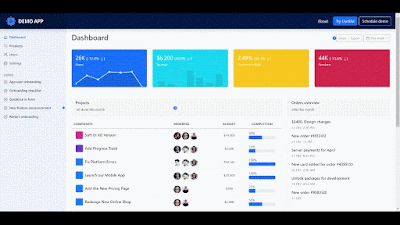 |
| Image by benzoix on Freepik |
User activation is one of the most critical and influential KPIs for your SaaS product. At its simplest, it describes the process of a prospect becoming an active user.
The steps required to get a user to that point are complex. However, a digital adoption platform can help. Let’s explore how. But first, let’s look at what user activation is and why it’s so crucial for your SaaS product.
What is user activation?
User activation is one of the essential parts of the buyer journey. It happens when users have gotten a benefit from your product to the point that they will pay for it or become regular or active users. Many people mix up the Aha moment with user activation. However, they describe two different things.
Let's explain this further.
The Aha moment happens when users realize what your SaaS product can do. They see it in action and understand its potential to help them do something quicker, cheaper, better, or whatever your USP is.
On the other hand, user activation is the point where they unlock that benefit. It's the difference between perceiving an advantage and actually benefiting from it.
For most SaaS brands, user activation starts with a product or demo. But, some people define it as the user reaching an onboarding milestone that will cause them to return for more.
Either way, it involves performing an action within your product to help them solve their pain point. So, however you want to define user activation, it generally refers to the steps a prospect takes to become a regular user of your product.
What's more, while user activation is typically used to describe a step in the buyer's journey, it's also applicable to your existing users. For example, if you release a new feature in your SaaS software, activation can refer to users adopting this additional functionality. Finally, activation can also refer to reactivating users who haven't used your product for a while.
However, this article will mainly concentrate on moving new users from initial interactions to regular users.
Why is the user activation rate significant?
Your user activation rate is crucial because it can define the success of your business. Users are a finite resource, whether you acquire them organically or through paid ads.
You can blow your budget on ads or content marketing, but if that's not turning into active users, your product won't get anywhere.
Understanding what transforms people who show initial interest in your product into regular or paying users is crucial for SaaS teams. For starters, it can tell you what you're doing well and where you need to improve.
Secondly, a strong user activation rate is vital for SaaS companies that want investment. For example, if a VC sees that your product converts trials and demos at a reasonable rate, they'll understand that increasing customer acquisition funds will help the product grow or scale. Put another way, they’ll see you as a viable investment.
Overall, if you want people to adopt your product, you must ensure you offer an excellent user experience. Get that right, and your user activation rate will increase.
Why do brands need to understand user activation?
The Pirate Metrics are a big concept for product-led growth (PLG) and SaaS businesses. They take their name from the acronym AARRR, which stands for:
Awareness
Activation
Retention
Referral
Revenue
Each step helps businesses categorize a set of metrics to track during each stage of the customer journey. User activation is the second phase the companies need to keep an eye on. The power of Pirate Metrics is that they can help you pinpoint friction in your sales funnel so that you know exactly what to fix.
But what steps are involved in user activation? Let's find out.
How to measure the user activation rate?
Measuring user activation involves a few different metrics. While one of them is the user activation rate itself, you can use several other KPIs to break down the concept.
Here are a few metrics that will help you get this crucial information.
User Activation Rate
If you want to track your SaaS product's user activation rate, you first need to define what counts as an activation to you. For the purposes of this article, let’s define user activation as an action within your product where the user gets a benefit.
Let’s say that your product is email automation software. Your user activation moment would be when your user sends out their first set of emails.
So to track the user activation rate, you need to track the number of users who signed up or downloaded your trial or demo along with the users who sent out automated emails.
Plug these numbers into the formula below, and you'll have your user activation rate:
User activation rate = (users who sent email / users who signed up) x 100
Sign up to subscriber rate
Sign-up to subscriber rate is another metric closely related to your user activation rate. The formula is pretty similar. However, each metric measures separate things.
You can calculate it with the following formula:
Signup to subscriber rate = (subscribers / signups)
Of course, there are other metrics that you can track alongside user activation rate that will give you more ideas about how your product is doing, such as:
Daily Active Users (DAU)
Monthly Active Users (MAU)
Churn Rate
What can user activation rate tell you about onboarding
While you can view user activation as a discrete metric, it needs to be understood in the overall content of the buyer journey. As such, it's tangled up with your entire onboarding process.
If you have a low activation rate, it's a sure sign that your onboarding isn't working well. Some reasons why your activation rate is low:
Your onboarding doesn't explain your product well
Your product is hard to use
Your onboarding process has too many steps
Your product has UX design flaws
Your marketing is attracting the wrong audience
If you suspect that any of these reasons relate to your product, have a look at these 7 onboarding best practices to get some ideas about where you can improve.
How to increase the user activation rate?
Now that you know how to measure the user activation rate and diagnose any problems, it's time to move on to the cure.
What it all comes down to is that you want your product to be sticky. Acquiring prospects takes time and money; each one is precious. A strong onboarding experience is a reliable predictor for converting prospects into users. It’s one of the most important elements of product adoption.
Here are some of the best ways to achieve solid user activation rates through Usetiful's range of excellent features.
#1. Sell with an interactive product demo
The activation process starts with your prospect's first interaction with your product. Our interactive product demo feature gives users a chance to get to grips with your product by exploring it themselves in their own time.
 |
| Interactive product demo by Usetiful. |
Of course, Usetiful can help you automate your entire onboarding experience, too. Check out this case study for how we helped Ahruf achieve success through automation.
#2. Remove friction with smart tips
Some products are complex and require a lot of customer education. Others are simple and intuitive, so they only need a little nudge here or there. Smart tips are perfect for both scenarios.
You can use smart tips to give new users small contextual hints and guidance for filling out forms, showing what specific graphic elements do, or offering other types of subtle, inobtrusive online help.
 |
| Usetiful Smart Tips provide non-disruptive hints in guidance for filling out forms. |
Have a read of this case study to see how roHealth used in-app assisted tours, smart tips, and guides to almost double their onboarding completion rate.
#3. Help them bed in with a product tour
Good onboarding experiences influence user activation rates. A big part of that is showing your users how your product can make their life easier. Usetiful product tours will help guide users to their Aha moment, empowering them to get value from your solution. From there, they can become active users. What's more, you can use the Reporting feature to understand the areas where your prospects need help. This feedback can help you improve your product and reduce friction.
Check out this article to see how we helped Calendify increase its user activation by 25% by implementing Usetiful product tours.
#4. Offer help using Assistant
We all need a little help from time to time. Customer self-service is the preferred choice for many customers these days because it allows them to seek help when they need it, 24/7. For businesses, customer self-service has many advantages, too, including reducing support tickets and saving on overheads.
Tools like Usetiful Assistant can help with activation because they offer new users 24/7 support and access to help documents and FAQs.
#5. Take them to the AHA moment with a checklist
If you've got a complex product or a multi-step pathway to user activation, checklists are here to help. Breaking down the onboarding process into easily digested stages enables you to design the path your prospects need to realize the benefits of your product.
With the right checklist, you can build efficient onboarding processes that take your prospects from their first interaction to becoming active users. Gamifying your onboarding is excellent for keeping users focused on unlocking the benefits of your product.
#6. Get onboarding feedback with a survey
Perfecting your onboarding flow and increasing user activation is something of a science. You need as much data as possible to understand why users become active and just as much information for why they don't.
Usetiful allows you to collect these data with in-app surveys. The insights you generate can help you understand your user base, identify points of friction, and use all that feedback to improve your product and your onboarding process.
Final thoughts
User activation is a critical part of the Pirate Metrics framework that is so popular in SaaS. It's also a stage in many funnels and buyer's journeys. Tracking this step is really important because it's so influential on a company's ability to grow or scale.
Using a digital adoption platform like Usetiful can help you smooth out your onboarding process. When you understand your users and eliminate the barriers to product adoption, you can increase your user activation. Take a look at our demo or go for a 14-day free trial today to see how we can help.

